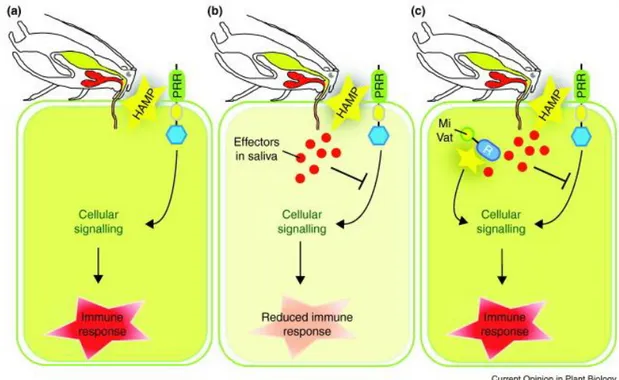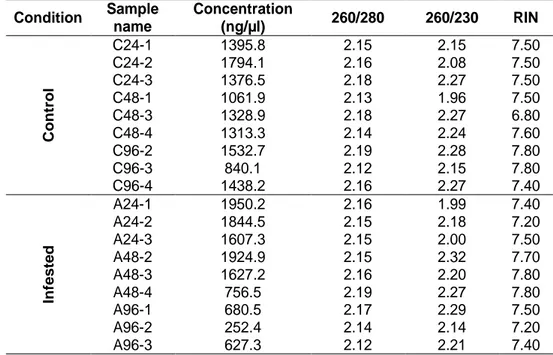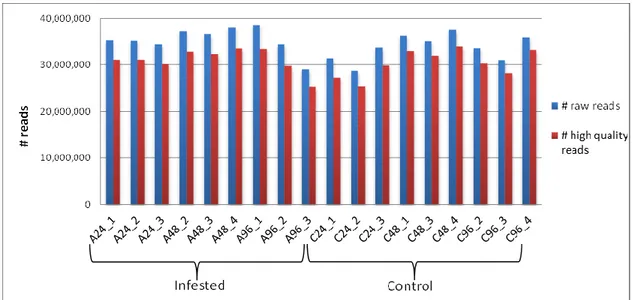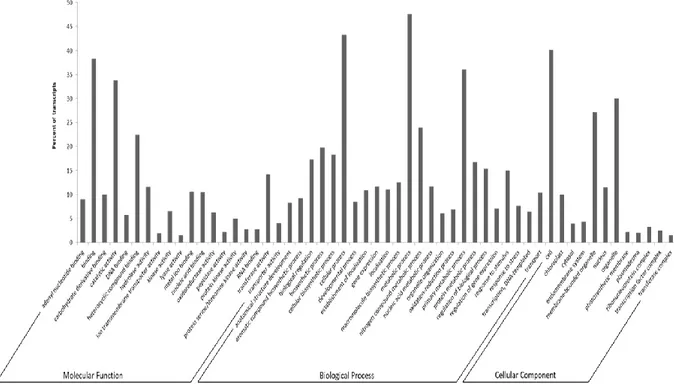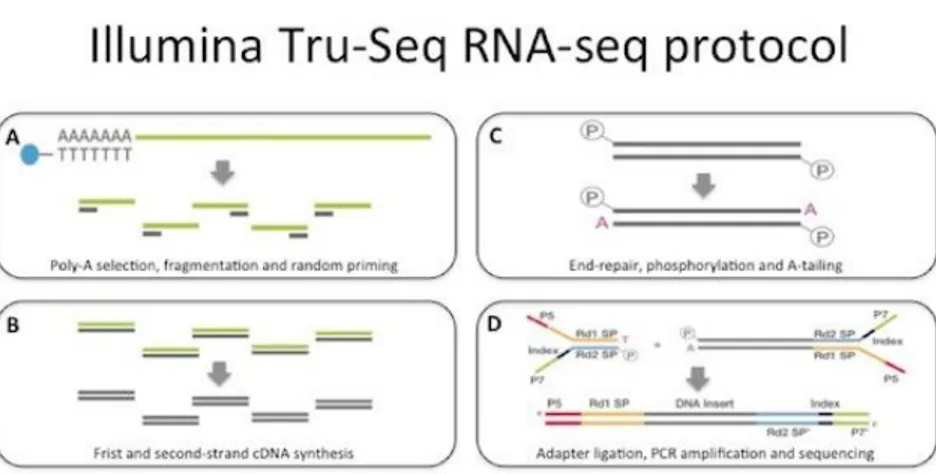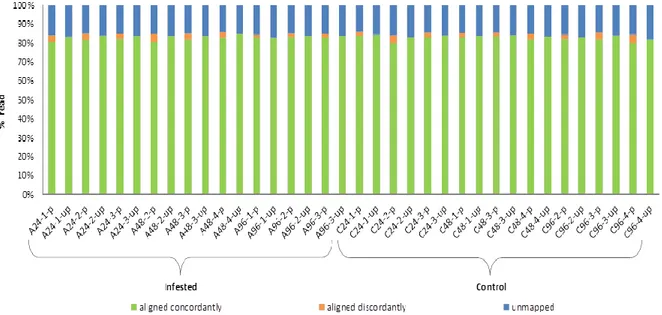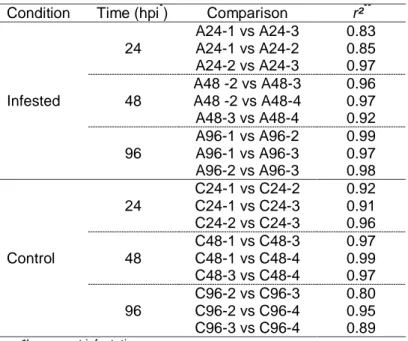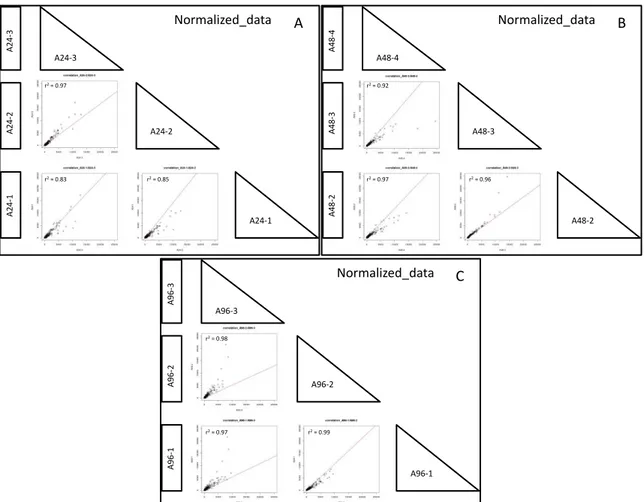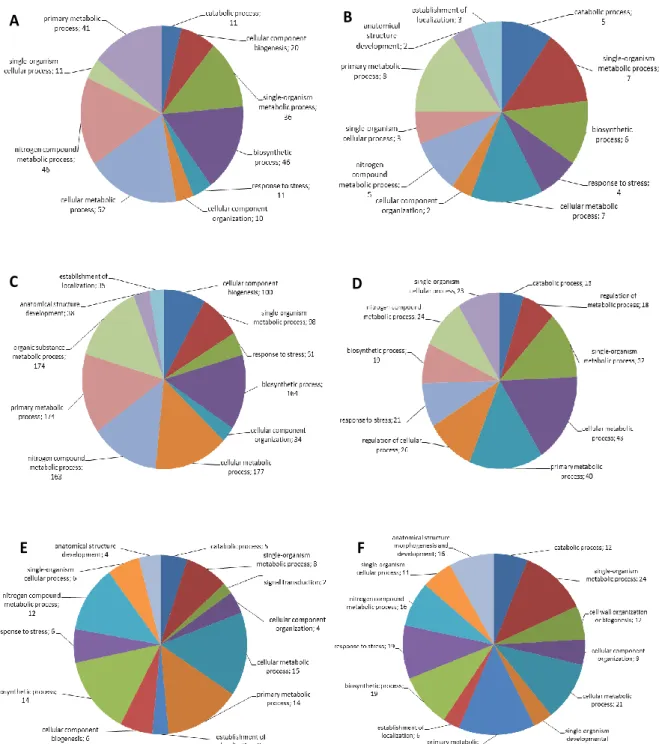T
T
R
R
A
A
N
N
S
S
C
C
R
R
I
I
P
P
T
T
O
O
M
M
E
E
C
C
H
H
A
A
R
R
A
A
C
C
T
T
E
E
R
R
I
I
Z
Z
A
A
T
T
I
I
O
O
N
N
A
A
N
N
D
D
T
T
R
R
A
A
N
N
S
S
C
C
R
R
I
I
P
P
T
T
I
I
O
O
N
N
A
A
L
L
R
R
E
E
P
P
R
R
O
O
G
G
R
R
A
A
M
M
M
M
I
I
N
N
G
G
O
O
F
F
Z
Z
U
U
C
C
C
C
H
H
I
I
N
N
I
I
P
P
L
L
A
A
N
N
T
T
I
I
N
N
R
R
E
E
S
S
P
P
O
O
N
N
S
S
E
E
T
T
O
O
A
A
P
P
H
H
I
I
S
S
G
G
O
O
S
S
S
S
Y
Y
P
P
I
I
I
I
F
F
E
E
E
E
D
D
I
I
N
N
G
G
Alessia Vitiello
Dottorato in Biotecnologie – XXX ciclo
Università di Napoli Federico II
T
T
R
R
A
A
N
N
S
S
C
C
R
R
I
I
P
P
T
T
O
O
M
M
E
E
C
C
H
H
A
A
R
R
A
A
C
C
T
T
E
E
R
R
I
I
Z
Z
A
A
T
T
I
I
O
O
N
N
A
A
N
N
D
D
T
T
R
R
A
A
N
N
S
S
C
C
R
R
I
I
P
P
T
T
I
I
O
O
N
N
A
A
L
L
R
R
E
E
P
P
R
R
O
O
G
G
R
R
A
A
M
M
M
M
I
I
N
N
G
G
O
O
F
F
Z
Z
U
U
C
C
C
C
H
H
I
I
N
N
I
I
P
P
L
L
A
A
N
N
T
T
I
I
N
N
R
R
E
E
S
S
P
P
O
O
N
N
S
S
E
E
T
T
O
O
A
A
P
P
H
H
I
I
S
S
G
G
O
O
S
S
S
S
Y
Y
P
P
I
I
I
I
F
F
E
E
E
E
D
D
I
I
N
N
G
G
Alessia Vitiello
Dottorando:
Alessia Vitiello
Relatore:
Prof. Rosa Rao
Correlatore:
Dott. Nunzio D’Agostino
RIASSUNTO 1
SUMMARY 6
CHAPTER 1-General Introduction 8
CHAPTER 2-De novo transcriptome assembly of the zucchini variety “San Pasquale” Abstract 20 2.1 Introduction 20 2.2 Results 22 2.3 Discussion 28 2.4 Conclusions 30
2.5 Materials and Methods 30
CHAPTER 3-Identification of zucchini (Cucurbita pepo L.) differentially expressed genes in response to Aphis gossypii feeding
Abstract 34
3.1 Introduction 34
3.2 Results 36
3.3 Discussion 51
3.4 Conclusions 56
3.5 Materials and Methods 56
CHAPTER 4-Identification of semiochemicals released by “San Pasquale” leaves upon infestation by Aphis gossypii
Abstract 60
4.1 Introduction 60
4.2 Results 62
4.3 Discussion 66
4.4 Conclusions 68
4.5 Materials and Methods 69
CHAPTER 5-General Conclusions 73
REFERENCES 77
APPENDIX 91
STAGE 117
1
RIASSUNTO
Gli insetti dotati di apparato boccale puntente-succhiatore, tra i quali gli afidi, sono tra i principali agenti di danno per le colture. Essi, infatti, grazie alla loro modalità di alimentazione, sottraggono linfa elaborata e fotosintati alla pianta ospite, modificandone in maniera profonda la fisiologia. Gli afidi producono un ridotto danno meccanico in confronto agli erbivori con apparato boccale masticatore. Inoltre, la prolungata interazione che gli afidi stabiliscono con i tessuti della pianta si traduce nell’attivazione di processi di difesa in gran parte diversi da quelli attivati in risposta agli insetti masticatori. Attualmente, il controllo degli afidi si basa principalmente sull’uso di pesticidi che si traduce in un forte impatto negativo sull’ambiente, incluse le popolazioni microbiche del suolo e gli insetti benefici. Inoltre, biopesticidi di origine naturale ampiamente diffusi, come quelli costituiti da spore e molecole prodotte da
Bacillus thuringiensis, sono disponibili per il controllo di insetti masticatori come
lepidotteri e coleotteri, ma non per il controllo degli afidi. Per questi motivi è importante potenziare le difese endogene delle piante (identificando geni in grado di conferire resistenza o tolleranza) e sviluppare strategie di controllo integrato per la difesa delle colture (Le Mire et al., 2016). Lo zucchino (Cucurbita pepo L.) appartiene alla famiglia delle Cucurbitaceae, alla quale appartengono anche cetriolo, melone e anguria, e alcune delle più antiche specie vegetali domesticate. Lo zucchino è tra le specie vegetali di maggiore importanza economica ed è coltivato nelle regioni temperate e subtropicali (Paris, 2008). L’Italia è l’ottavo paese produttore a livello mondiale ed il primo dell’area mediterranea, con più di 566.000 tonnellate prodotte nel 2014 (FAOSTAT 2014).
L’afide Aphis gossypii Glover è un fitofago polifago in grado di alimentarsi su diverse specie vegetali, tra le quali cotone e diverse cucurbitacee. Questo insetto è tra i principali agenti di danno nella coltivazione dello zucchino sia in pieno campo sia in ambiente protetto, ed è in grado di provocare danni diretti alle piante, come accartocciamento fogliare, avvizzimento e riduzione della crescita. In condizioni di gravi infestazioni possono comparire aree clorotiche e necrosi su foglie e frutti che provocano una forte riduzione della resa. Inoltre, A. gossypii è vettore di numerosi virus, come ad esempio lo ZYMV (Zucchini Yellow Mosaic Virus) che è tra i più dannosi per lo zucchino. I frutti prodotti da piante infette da ZYMV sono generalmente malformati, producono pochi semi e sviluppano alterazioni del colore rendendo il prodotto non commercializzabile (Zellnig et al., 2014).
Ad oggi non sono stati ancora pubblicati studi relativi alle modifiche trascrizionali in zucchino attivate in risposta all’attacco di afidi e ai meccanismi molecolari associati al danno. Le nuove tecnologie di sequenziamento (NGS) rappresentano un importante strumento per studiare nel dettaglio i meccanismi molecolari che regolano l’interazione pianta-afide. In modo particolare, l’uso dell’RNA-seq offre il vantaggio di ottenere una visione globale delle modifiche trascrizionali che si verificano in seguito all’infestazione afidica. La strategia RNA-seq risulta molto efficiente per lo studio di trascrittomi di specie vegetali per le quali le risorse genomiche a disposizione sono scarse in confronto alle specie vegetali modello.
In questo scenario, il lavoro qui presentato si pone come principale obiettivo quello di indagare le modifiche trascrizionali in piante di zucchino in seguito all’attacco di afidi mediante approccio RNA-seq e di identificare le vie metaboliche attivate dall’infestazione e legate alla difesa diretta e indiretta della pianta.
Il trascrittoma utilizzato come riferimento in questo studio è stato assemblato de novo a partire dai tessuti fogliari infetti e non, ed è stato usato per l’identificazione dei geni la cui espressione è risultata alterata dalla presenza degli afidi.
2
Piante di zucchino della varietà campana “San Pasquale”, suscettibile ad A. gossypii, sono state infestate con 10 afidi adulti dopo tre settimane dalla semina. Per monitorare cambiamenti nell’espressione genica, le foglie sono state raccolte dopo 24, 48 e 96 ore dall’infestazione e congelate immediatamente in azoto liquido, rimuovendo prima gli afidi presenti. Foglie corrispondenti sono state prelevate da piante controllo (non infestate) allevate nelle stesse condizioni ambientali di quelle attaccate. Dai tessuti fogliari raccolti è stato estratto l’RNA totale, che è stato successivamente sequenziato utilizzando la piattaforma Illumina HiSeq 2500. L’esperimento di sequenziamento ha prodotto ~34 milioni di paired-end read di 101 nucleotidi per ciascun campione. Le read ottenute sono state ripulite dagli adattatori e filtrate per eliminare le sequenze corte (< 75 nt) e quelle con un valore di qualità inferiore alla soglia stabilita (Q score ≤ 30). Le read di alta qualità ottenute sono state utilizzate per condurre l’assemblaggio de novo del trascrittoma di zucchino. Il programma di assemblaggio selezionato (Velvet/Oases, Schulz et al., 2012) ha consentito di ricostruire 122.507 contig che sono poi stati “collassati” per ridurre la ridondanza e gli eventuali errori di assemblaggio utilizzando il software CAP3 (Huang and Madan, 1999). È stato quindi ottenuto un trascrittoma costituito da 71.648 sequenze, con una lunghezza media di 1.331 nucleotidi. Circa il 94% dei trascritti assemblati è stato classificato come ipotetica sequenza codificante, in quanto presentava elementi tipici di una ORF. Questo risultato è un importante indice della qualità dell’assemblaggio ottenuto. Inoltre, i trascritti sono stati annotati al fine di attribuire una funzione biologica al maggior numero di essi. Analisi BLAST sono state condotte confrontando il trascrittoma assemblato con le banche dati di sequenze proteiche di C. sativus, C. melo, Arabidopsis e con la banca dati UniProt. Mediamente il 70% delle sequenze assemblate ha trovato almeno una corrispondenza all’interno dei quattro database interrogati. Il programma Blast2GO (Götz et al., 2008) ha poi permesso di associare almeno un termine “gene ontology” (GO) a 51.398 sequenze in modo da poter descrivere le funzioni di tali trascritti utilizzando un vocabolario univoco. In totale sono stati associati 276.601 termini GO, di questi il 50% è stato assegnato al dominio funzionale “processo biologico”, il 27% al dominio “funzione molecolare” ed il 21% al “compartimento cellulare”. È stato inoltre confrontato il trascrittoma assemblato con quello disponibile in rete (pubblicato da Blanca et al., 2011). Il risultato dell’analisi BLASTn ha evidenziato la presenza di 1.313 nuovi trascritti le cui funzioni ricadono anche in processi metabolici noti per essere attivati in risposta al danno biotico (insetti e/o patogeni). Quest’ulteriore dato conferisce un valore aggiunto alla risorsa trascrittomica generata, rafforzando anche la scelta di costruire un proprio riferimento per consentire di descrivere al meglio la risposta molecolare della pianta all’attacco afidico.
I cambiamenti nell’espressione genica durante le prime fasi dell’interazione compatibile tra zucchino “San Pasquale” e A. gossypii sono stati analizzati nei tre diversi tempi di infestazione. A 24, 48 e 96 h dall’attacco di A. gossypii, 766 geni sono stati identificati come differenzialmente espressi (DEG) e quindi influenzati dall’afide. In particolare, dopo 24 h di infestazione sono stati identificati 158 trascritti (115 up- e 43 down-regolati). A 48 h il numero di DEG è aumentato a 565 (420 up- e 145 down-regolati), mentre a 96 h dall’infestazione è stata osservata una variazione nell’espressione di 179 sequenze (62 up- e 117 down-regolati). Quindi, il numero di geni coinvolti nella risposta della pianta all’attacco dell’afide raggiunge il suo massimo a 48 h, implicando l’attivazione di una risposta dinamica e crescente della pianta nelle prime fasi di attacco per poi assistere ad una attenuazione della risposta nell’ultimo punto temporale.
3
Nelle condizioni sperimentali saggiate, durante le prime fasi dell’interazione, la pianta di zucchino percepisce la presenza dell’afide e attiva geni coinvolti in vie di segnalazione mediate da incrementi di calcio citosolico, e geni che codificano per enzimi associati alla detossificazione delle specie reattive dell’ossigeno (ROS). Il metabolismo primario, in particolare il metabolismo proteico e la fotosintesi, risultano attivati a differenza di quanto riportato in diversi studi di interazione condotti su altre specie vegetali. Questa risposta potrebbe essere direttamente legata alla presenza di effettori afidici che dirigono il metabolismo della pianta ospite alle esigenze nutrizionali degli afidi.
Inoltre, la sintesi di acido salicilico (SA) è attivata grazie alla sovra-espressione del gene ICS1 coinvolto nel pathway biosintetico di tale ormone. Per quanto riguarda, invece, un altro ormone chiave nella risposta a insetti, l’acido jasmonico (JA), non è stato identificato tra i DEG nessun trascritto associato alla sua biosintesi. Invece, geni codificanti per inibitori di proteasi, che sono generalmente attivati in risposta alla sintesi di JA, sono risultati sotto-espressi.
Anche il metabolismo secondario è influenzato già a 24 h. Un gene codificante per l’enzima 4CL, che catalizza l’ultima reazione del pathway generale dei fenilpropanoidi che regola la produzione di molti composti tra cui lignina e flavonoidi, è risultato sovra-espresso.
A 48 h è stata osservata l’induzione di geni dipendenti dall’acido salicilico e correlati alla patogenesi (PR), mentre geni dipendenti dal JA quali inibitori delle serine proteinasi sono sempre down-regolati. Inoltre, un trascritto annotato come NIMIN1 è stato identificato tra i geni sotto-espressi. Questo gene codifica per un regolatore negativo di NPR1/NIM1 che svolge un ruolo fondamentale nel regolare la risposta sistemica acquisita (SAR) e nella via di segnalazione mediata dall’acido salicilico (Weigel et al., 2001). Tali modifiche trascrizionali potrebbero essere legate al tentativo della pianta di attivare risposte di difesa mediate dall’acido salicilico, e queste, secondo un meccanismo da chiarire, potrebbero antagonizzare la via di risposta legata all’acido jasmonico. Ad avvalorare questa ipotesi è anche il risultato di biosaggi effettuati sul comportamento degli afidi quando posti ad alimentarsi su piante di zucchino già precedentemente infestate, oppure pre-trattate con methyl salicilato (MeSA). Gli afidi posti su foglie di zucchino pre-infestate hanno mostrato un’alterazione nel comportamento. Infatti, meno del 50% degli afidi saggiati è stato ritrovato sulla foglia pre-infestata sulla quale erano stati posti, tendendo a spostarsi per cercare un nuovo sito di alimentazione. Lo stesso comportamento è stato registrato per afidi posti su piante pre-trattate con MeSA. Confrontando il numero di afidi che si arrampicavano sullo stelo di piante non trattate per alimentarsi (80%) con quello ritrovato sulle piante pre-trattate (circa il 47%), si può affermare che il MeSA ha esercitato un ruolo importante nel condizionare il comportamento degli afidi. Tale risultato è comparabile con quanto osservato su piante pre-infestate per le quali vi è stata attivazione della risposta di difesa.
A 48 h dall’infestazione il metabolismo primario risulta sempre attivato, ed in particolar modo la sintesi di proteine ribosomiali (più di 80 geni), sia citosoliche sia plastidiali, risulta fortemente regolata. Dopo 48 h risultano anche fortemente up-regolati diversi geni coinvolti nella sintesi e modifica di componenti della parete cellulare, che rappresentano un meccanismo di difesa diretto contro i fitomizi. A 96 h la prevalenza di geni down-regolati, insieme con la riduzione, rispetto alle 48 h, del numero di DEG, può essere legata ad un meccanismo di adattamento alla presenza dell’agente di danno e al progredire dell’infestazione. Infatti, i processi di detossificazione dei ROS risultano down-regolati e anche la via di segnalazione del
4
calcio è influenzata negativamente. Il numero di geni legati al metabolismo proteico è fortemente ridotto in confronto alle 48 h, anche se ad essere down-regolati sono geni codificanti per proteasi (aspartic proteinase). Anche i geni coinvolti nella modifica della parte cellulare sono tutti down-regolati durante l’ultimo tempo di analisi, e codificano sia per classi di enzimi coinvolti nella degradazione, ad esempio poligalatturonasi, sia per enzimi coinvolti nel rafforzamento della parete cellulare (AGPs). Tra i geni fortemente down-regolati coinvolti nel metabolismo secondario è stata anche annotata una Terpene synthase. Enzimi appartenenti a questa classe sono attivi nel pathway dei terpenoidi, e quindi nella sintesi di una classe composti organici volatili (VOC), i quali svolgono un ruolo importante nelle risposte indirette delle piante, richiamando i nemici naturali dell’insetto fitofago. Allo scopo di associare alla descrizione dei geni influenzati da A. gossypii in zucchino “San Pasquale” anche quella relativa alle molecole coinvolte nelle risposte indirette, i volatili emessi in seguito all’attacco sono stati raccolti in esperimenti di “air entrainment”. Le analisi GC e GC/MS hanno rivelato la produzione di un numero ristretto di molecole volatili. Quando le piante sono state infestate con 10 afidi adulti per 48 h è stata osservata una significativa riduzione dei livelli di emissione di (E)-caryophyllene, ma non sono state trovate differenze significative per gli altri volatili. Inoltre, anche analizzando i volatili emessi da piante infestate con 300 afidi non sono state identificate molecole emesse in maniera differenziale rispetto alle piante controllo. L’alta densità di infestazione ha però influenzato in modo significativo l’incremento dell’emissione di (E)-caryophyllene a partire da 96 h dopo l’inizio dell’infestazione. Il (E)-caryophyllene è un metabolita appartenente alla classe dei sesquiterpeni ed è coinvolto nei processi di comunicazione delle piante con l’ambiente esterno. In particolare, numerosi studi hanno dimostrato il suo coinvolgimento in pomodoro e mais, anche in associazione ad altri volatili come il 6-methyl-5-hepten-2-one, nell’attrazione di nemici naturali degli afidi (Sasso et al., 2007; Köllner et al., 2008). Sono stati inoltre eseguiti biosaggi per valutare il comportamento in risposta all’(E)-caryophyllene sintetico di A. gossypii e di un suo nemico naturale, il parassitoide Ahidius colemani, molto utilizzato in programmi di lotta integrata. Dai saggi condotti in olfattometro a 4-vie è emerso che il parassitoide trascorre la maggior parte del tempo nella sezione relativa al (E)-caryophyllene rispetto alle sezioni controllo, in cui è posto il solo solvente. Pertanto il parassitoide risulta attratto in maniera significativa dal composto testato. Emerge quindi un ruolo chiave per questo volatile nell’interazione pianta-afide. Risulterà importante andare a chiarire quale meccanismo mediato dagli afidi regola la soppressione della emissione del (E)-caryophyllene in piante infestate con un basso numero afidi, ma che non può essere mantenuta in caso di elevata densità di infestazione.
Infine, dall’analisi trascrizionale è emerso un dato decisamente interessante ed al tempo stesso atipico, in quanto, a nostra conoscenza, non è riportato in nessuno studio di interazione pianta-afide pubblicato fino ad oggi. Fin dal primo punto temporale analizzato, sono stati identificati tra i DEG degli mRNA di origine afidica, il cui livello di espressione è poi aumentato nel tempo. Riteniamo che tali trascritti siano stati iniettati nei tessuti vegetali durante il processo di alimentazione degli afidi e siano stati prodotti dalle cellule delle ghiandole salivari, come confermato dalla’identità di sequenza riscontrata in seguito al confronto con il trascrittoma delle ghiandole salivari di A. gossypii (Pennacchio et al., unpublished).
Allo stato attuale delle conoscenze non è chiaro quale sia il ruolo di questi mRNA di origine afidica all’interno dei tessuti vegetali, ma un’ipotesi potrebbe essere quella che l’afide tenta di regolare il metabolismo e la risposta di difesa della pianta ospite a
5
proprio vantaggio anche attivando meccanismi di soppressione di alcune vie metaboliche chiave nella risposta a stress.
In conclusione, in questo studio è stata indagata, per la prima volta, la risposta molecolare della pianta di zucchino all’attacco afidico, mostrando quanto questa sia complessa e regolata da numerosi fattori.
Le informazioni e le conoscenze prodotte nella presente tesi rappresentano un fondamentale punto di partenza per sviluppare efficaci strategie per il controllo di
Aphis gossypii, anche attraverso l’uso di tecniche innovative di breeding, quali il
6
SUMMARY
Zucchini (Cucurbita pepo L.) belongs to the Cucurbitaceae family and ranks among the highest-valued vegetables worldwide. It is widely cultivated in temperate region where one of the main problem related to its cultivation is the damage imposed by the cotton/melon aphid Aphis gossypii (Homoptera: Aphididae). Aphis gossypii is a polyphagous aphid which can both directly and indirectly affects host plant by inducing leaf curling and necrosis and vectoring several plant viruses. Plants can defend themselves against aphids using different strategies. A direct response activates a deep transcriptional reprogramming which leads to de novo synthesis of proteins and molecules implicated in defence, including production of herbivore induced volatile organic compounds (HI-VOCs), which can indirectly attract herbivore natural enemies.
In the present study, the mRNA from un-infested (control) and infested leaves by A.
gossypii of C. pepo cultivar “San Pasquale” was sequenced to obtain a de novo
transcriptome assembly to be used as reference for gene expression profiling.
Leaf material was collected from control and infested (10 adult A. gossypii) plants at three different time points (24, 48, 96 hours post infection; hpi) and RNA was extracted. Illumina sequencing generated ~34 million of paired-end reads of 101 nucleotides in length per sample. Short reads were pre-processed and, then, de novo assembled using Velvet/Oases and CAP3 tools into a non-redundant set of 71,648 transcripts. Approximately 94% of the assembled transcripts contains coding sequences that could be translated into proteins, and ~70% of transcripts was successfully annotated using BLAST similarity-based searches and Blast2GO. Furthermore, BLASTn comparisons with the publically available C. pepo transcriptome resulted in 1,313 transcripts exclusively assembled in the aphid-challenged transcriptome.
Following transcriptome assembly, a dataset of 42,517 sequences, in which each gene locus was represented only once, was filtered out and used as reference for read mapping and differentially expressed gene (DEG) call. A total of 766 transcripts was differentially expressed (FDR< 0.05; -2˂logFC˃2). At 24 hpi, 158 transcripts were influenced by aphid infestation. The number of affected transcripts increased to 565 at 48 hpi and declined to 179 transcripts at 96 hpi. The analysis of DEGs highlighted the modulation of genes involved in hormone-related defence pathways. Among these, SA-related genes were found mainly up-regulated assuming an important role in “San Pasquale”-A. gossypii interaction. Furthermore, a significant negative effect on aphid fixing behaviour was observed on zucchini plants pre-treated with synthetic methyl salicylate (MeSA). Zucchini plant response was also characterised by the overexpression of genes involved in primary metabolic processes as well as cell wall modification. Interestingly, several aphid-derived transcripts were discovered among zucchini DEGs. Even if no conclusive evidence can be drawn, we hypothesized that these mRNAs might play a role in modulation of plant direct and/or indirect response.
Finally, analysis of VOCs emitted by zucchini plants infested with 10 adult aphids, for 48 h, showed a significant reduction in (E)-caryophyllene emission, whereas emission levels of other volatiles were not affected. Conversely, a significant increase in (E)-caryophyllene emission was observed when plants were infested with 300 adult aphids, for 96 h. Moreover, olfactometer bioassays revealed that synthetic (E)-caryophyllene was attractive to female Aphidius colemani parasitic waps, widely used as biological control agents for A. gossypii. Taken together, these results suggest
7
(E)-caryophyllene may play an important role in zucchini plant indirect defence responses.
Our study allows to elucidate, for the first time, the molecular mechanisms activated by zucchini plants in response to A. gossypii infestation during a compatible interaction.
8
1.1 Plant defence mechanisms against insect pest
Plants and insects that feed on them are actively implicated in a war since hundreds of millions of years. Insect pests cost billions of dollars in terms of crop losses and insecticides and farmers face an ever-present threat of insecticide resistance due to large use of chemical control agents (Gordon and Waterhouse, 2007). Furthermore, the massive use of insecticides involves tremendous damages to ecosystems that induce deep modification in soil microbial communities and lead to gradual contamination of soil and water resources. Hence, there is an urgent need to develop alternative pest-control strategies for crops reducing the amount of pesticides. For all these reasons the enhancement of plant endogenous defence, through the identification of new genes and molecules able to contain harmful insect population, is considered a suitable tool for crop protection in integrated pest management strategies (Le Mire et al., 2016).
Plants, in the course of evolution, have developed sophisticated systems to defend themselves against the attack of insect pests with different feeding strategies. Plant defences are commonly divided into constitutive and induced defences. Constitutive defences are physical and chemical defensive traits that plants have regardless of the presence of herbivores (Wu and Baldwin, 2010). By contrast, inducible defences are turned up only after plants are attacked by herbivores. Plant survival depends on its ability to quickly recognize, decipher the incoming signal, and adequately respond to it activating efficient defences. Such defences are triggered either to directly protect the plant, improving structural features and toxic compounds, or to indirectly protect it through molecular interactions that may attract natural enemies of herbivore insects such as predators or parasitoids. Direct defences are able to interfere with insect growth, development and reproduction using physical or chemical barriers. Physical barriers on plant surfaces, such as thorns, glandular trichomes and cuticles could prevent insect colonization and limit insect movement. Moreover, trichomes may also complement plant chemical defence producing substances that are olfactory or gustatory repellents. Plant direct defences include production of many secondary metabolites that act as powerful chemical weapons. These metabolites such as alkaloids, glucosinolates and cyanogenic glucosides, function as toxins, repellent or poisons. Moreover, proteinase inhibitors (PIs) are produced following insect attack and act as anti-digestive proteins, also reducing the nutritional value of crops. The generally accepted mode of action is that PI molecules inhibit protein digestive enzymes in insect guts, resulting in amino acid deficiencies and thereby developmental delay, mortality, and/or reduced fecundity (Gatehouse, 2011). Others defence-related proteins such as arginases, ascorbate oxidases, lipoxygenases, polyphenol oxidases, and peroxidases may have anti-nutritional properties (Mithöfer and Boland, 2012).
Plants indirect defences attract natural enemies of herbivores by releasing volatile organic compounds, green leaf volatiles and extra-floral nectars (Wu and Baldwin, 2010). The emission of volatile organic compounds (VOCs) by infested plants, that mainly consist of terpenoids, fatty acid derivatives, and aromatic compounds, can attract parasitoids or predators of the feeding insect (De Moraes et al., 1998; Kessler and Baldwin, 2001). Usually VOCs blend composition depends on the mode of damage but also on specific plant-herbivore interaction. The insect feeding-induced emission of volatiles facilitates the identification of target plants and the control of pest population. However, some VOCs can also serve in direct defences as repellents to the attacking insect. For example, tobacco plants emit nocturnal VOCs
9
that repel Heliothis virescens female moths from oviposition on previously damaged plants (De Moraes et al., 2001).
Biosynthesis of defensive compounds and activation of defence mechanisms are expensive, and it is not surprising that plants use complex regulatory systems to balance growth and development against defence. This is a problem especially when fitness-limiting resources, like nitrogen, are invested or if the compounds produced are toxic to the plant itself, and not only to the herbivores (Fürstenberg-Hägg et al, 2013). Induced defences are complex also because different types of organisms could be recognised and elicit different responses. Chewing herbivores burst vacuoles and trichomes determining the release of defensive compounds. Piercing/sucking insects, such as aphids, do less structural damage but divert nutrient flow from the plant (Bruce and Pickett, 2007). Thus, defence response of plants changes according to different type of stressors.
1.2 Recognition of insect herbivore attack
Plants have the ability to recognise mechanical damage and to properly respond to herbivore attacks. This feature is essential to avoid wasting precious resources, since production and release of defence compounds only benefits herbivore-challenged plants (Fürstenberg-Hägg et al, 2013). Plants defence mechanisms are activated considering herbivores feeding strategy and the quality and quantity of tissue damaged by insect pests. Moreover, herbivore-derived elicitors contained in oral secretions, also described as HAMPs (herbivore-associated molecular patterns), and herbivore-induced molecules originated form plants, elicit and modulate plant defence responses. HAMPs are described as all herbivore-derived signalling compounds that might come into contact with the particular host plants during any stage of their life cycle and thereby elicit defence reactions (Mithöfer and Boland, 2008). The first fully characterized herbivore-derived elicitor has been volicitin or N-(17-hydroxylinolenoyl)-L-glutamine, a hydroxy fatty acid-amino acid conjugate (FAC), which has been isolated from the beet armyworm Spodoptera exigua oral secretions (Alborn et al., 1997). The application of volicitin greatly enhances volatile emission in
Zea mays seedlings, which attracts parasitoids to feeding larvae (Alborn et al., 1997).
Since then, FACs have been found in oral secretions of several Lepidopteran species (Spiteller and Boland, 2003; Pohnert et al., 1999; Halitschke et al., 2001), and also in crickets (Teleogryllus taiwanemma) and fruit flies (Drosophila melanogaster) (Yoshinaga et al., 2007). FACs have been shown to play a key role in insect nitrogen metabolism (Yoshinaga et al., 2008), and hence it may be demanding for insects to avoid to synthesize FACs so as to feed stealthily on plants that use FACs to detect pest attack (Wu and Baldwin, 2010). In addition to FACs, several other types of elicitors in insect oral secretions have been discovered. For example, inceptins derived from proteolysis of the plant chloroplastic ATP synthase γ-subunit (cATPC) was identified in Spodoptera frugiperda midgut (Schmelz et al., 2006). Small amounts of inceptin tested on mechanically damaged leaves of Vigna unguiculata (cowpea) are able to significant increase intracellular levels of hormones involved in stress signalling pathways (Schmelz et al., 2007). Another class of elicitors, caeliferins, has been identified in American bird grasshoppers, Schistocerca
Americana. In contrast to previous examples, a few number of elicitors characterized
from oral secretions are able to suppress plant defence responses, as described for salivary glucose oxidase (GOX) secreted by Helicoverpa zea that can inhibit wound-inducible nicotine production in Nicotiana tabacum (Musser et al., 2005). More recently, several studies on effectors released by piercing/sucking insects, such as
10
aphids, were performed. The candidate effector protein Mp10, produced by the green peach aphid Myzus persicae, specifically induced chlorosis and local cell death in
Nicotiana benthamiana, indicating that this protein may trigger plant defences.
Moreover, aphid fecundity assays revealed that N. benthamiana plants overexpressing Mp10 showed a negative effect reducing aphid fecundity (Bos et al., 2010). Moreover, N. benthamiana plants overexpressing Mp10 activated hormone-related defence signalling and reduced susceptibility to the oomycete P. capsici (Rodriguez et al., 2014). Aphid salivary proteins can also facilitate feeding from host plants. Arabidopsis thaliana plants overexpressing the M. persicae salivary effector Mp55 showed increased aphid reproduction in response to aphid feeding. Mp55-expressing plants also were more attractive for aphids in choice assays (Elzinga et
al., 2014).
Given the diversity of herbivore species and the very different fitness consequences of their attack of the plants, it is reasonable to assume that plants have developed multiple receptors and sensors that form a complex surveillance system for herbivores. Depending on the effector introduced by the insect into the plant, different signalling events may be triggered by a single or a specific combination of receptors/sensors (Wu e Baldwin, 2010).
1.3 Plant-aphid interaction
Aphids are major economic insect pests of plants that cause yield losses worldwide. These insects are phloem-feeders and belong to Aphididae family, which comprises more than 4300 species. Damage to plants as a consequence of aphid infestation can result in water stress, reduced plant growth and wilting. In particular, aphids can manipulate resource allocation within the plant. Aphids increase the nutritional quality of their feeding sites by enhancing the import of resources from other sites in the plant, mobilizing local resources and blocking their export to other organs (Goggin, 2007). Moreover, these insects are major vectors of economically important plant viruses. Aphids can reproduce clonally and give birth to live young, in which embryonic development begins before its mother's birth (Goggin, 2007). These traits allow for short generation times and contribute to have a tremendous negative impact on host plants. Most aphids are specialized and can only feed on one or few related plant species. However, polyphagous aphid species are considered the most dangerous because of their ability to infest many plant species, including important crops (Jaouannet et al., 2014). For all these reasons it is important to identify factors that regulate plant resistance or susceptibility to these insects as background information to develop biotechnological applications for plant protection.
Prior aphids feeding activity starts, some steps are involved in initial contact with the host plant. Aphids first need to localize the host plant, usually taking advantage of volatiles emitted, and to land on it surfaces. Thin and elongated mouthpart, called stylets, enables aphids to penetrate plant tissue compartments (figure 1.1) (Powell et al. 2006). Moreover, a probing behaviour takes place during both aphid-host and aphid-non-host interactions, during which a molecular interaction occurred to check the compatibility of the plant species. However, during non-host interactions aphids cannot successfully feed from the phloem.
11
Figure 1.1. Schematic representation of a feeding aphid. e: epidermis; hd: honeydew droplet; l:
labium, not participating to the piercing activity (brown); p: parenchyma; sb: stylet bundle (orange); se: sieve elements (blue); ss: stylet sheaths (black); st: stylet tip (from Guerrieri and Digilio, 2008). The aphid stylet must penetrate the plant epidermis and move through the cortical layer. To facilitate this process, aphids secrete proteinaceous gelling saliva which hardens to form a continuous tubular sheath encasing the full length of the stylet within the apoplast (Will and Vilcinskas, 2015). Whereas, watery digestive saliva, which is a complex mixture of enzymes (e.g. oxidases, pectinases, and cellulases) and other components (e.g. effectors) able to enhance plant defence response (Smith and Boyko, 2007), is secreted during probing and phloem sap ingestion. The stylet penetration in plant tissue is able to activate the Ca2+ channels in the plasma membrane of sieve elements and to promote the Ca2+ influx from the apoplast into the sieve element lumen. Saliva proteins represent key elements in plant defence modulation and are considered to act as herbivore-associated molecular patterns (HAMPs) (Will et al., 2013).
1.4 Molecular pathways activated by aphid infestation
During the constant interaction between host plant and aphids, plant defences are likely to be triggered. Progresses based on transcriptomic studies have been made in recent years identifying the molecular pathways activated during plant-aphid interaction (Thompson and Goggin, 2006; Kusnierczyk et al., 2008; Coppola et al., 2013). A common feature of these studies is that plants activate responses that overlaps with those related to bacterial and fungal pathogens (Zhu-Slazman et al., 2005). Furthermore, the different researches, that have been carried out to study changes in gene expression induced by aphid, revealed that many of the differentially expressed genes encode proteins directly involved in defence and signalling,
12
oxidative brust, protein synthesis, modification and degradation, cell wall degradation and strengthening, cell maintenance, photosynthesis and secondary metabolites (Smith and Boyko, 2007; Kusnierczyk et al., 2008; Delp et al., 2009; Coppola et al., 2013). This means that plant response to sucking insects appears to be very complex (Foyer et al., 2014).
The recognition of aphid feeding by plants likely occurs through the use of transmembrane pattern recognition receptors (PRRs) or of polymorphic nucleotide-binding site-leucine-rich repeat (NBS-LRR) protein products, encoded by a majority of resistance genes that confer resistance to aphids, such as Mi-1.2 and Vat (Jones and Dangl, 2006). The Mi-1.2 resistance gene confers resistance in tomato to certain clones of Macrosiphum euphorbiae (potato aphid), two whitefly biotypes, a psyllid, and three nematode species (Kalosian et al., 1997; Rossi et al., 1998; Milligan et al., 1998; Kingler et al., 2005; Casteel et al., 2006; Francis et al., 2010), indicating that there is significant overlap in plant pathogen and aphid recognition in plants. The Vat gene from melon, Cucumis melo L., controls resistance to the cotton aphid Aphis
gossypii Glover, and to transmission of some non-persistent viruses vectored by A. gossypii (Dogimont et al., 2014). In addition, aphid resistance conferred by several
resistance genes was shown to be race-specific (figure 1.2, (c)) (Bos et al., 2010). Following the recognition of the attacker, plants activate different signal cascades that involve various signalling molecules to reprogram their phenotype (figure 1.2, (a)). Typical signal molecules include phytohormones such as Jasmonic Acid (JA), Salicylic Acid (SA), Ethylene (ET), and reactive oxygen/nitrogen species (ROS/RNS), mainly hydrogen peroxide (H2O2), and nitric oxide (NO); all induce alteration in the
expression of defence genes, enhancing plant defence responses (Drzewiecka et al., 2014). These molecules can act separately or together, with antagonistic or synergistic interactions in the plant signalling network (Morkunas and Gabryś, 2011).
Figure 1.2. Model of the multi-layered plant defence response to aphid herbivory proposed by
Hogenhout and Bos (2011). (a) Plant cells perceive aphid herbivore-associated molecular patterns (HAMPs) activating effective defence response that deters the aphid from further feeding. (b) Although plants perceive aphid HAMPs, the defence response is effectively suppressed by aphid effectors leading to aphid colonization. (c) The aphid species produces effectors that effectively suppress plant
13
responses, but in certain clones of this aphid species one or more effectors are being recognized by R genes leading to plant effective immune response and plant resistance to the aphid clone.
Jasmonic acid (JA) and ester-methyl jasmonate (MeJA) are linoleic acid-derived compounds and key molecules of the octadecanoid-signalling pathway (Meyer et al., 1984). The JA functions in plant–aphid interactions have been described in several plants such as Arabidopsis, tobacco, tomato, wheat and sorghum (Morkunas and Gabryś, 2011). Beside JA, its precursor, 12-oxo-phytodienoic acid (OPDA), and JA methyl ester (MeJA) are also essential elements in plant defence mechanism (Korth and Thompson, 2006) Several genes encoding enzymes involved in JA synthesis and JA-mediated defence responses, such as 12-oxophytodienoate 10,11-reductase,
Cytochrome P450 and lipoxygenase (LOX), were up-regulated in aphid-resistant
plants after the attack of aphids (Moran and Thompson, 2001; Voelckel et al., 2004; Boyko et al., 2006).
Salicylic acid (SA) promotes the development of systemic acquired resistance (SAR), a broad-range resistance against pathogens and it is involved in hypersensitive (HR) response (Smith and Boyko, 2007). The accumulation of SA and expression of SA-responsive genes following aphid feeding provided evidence of a possible involvement of this phytohormone in plant defence mechanism (Mohase and van der Westhuizen, 2002; Divol et al., 2005; Zhu et al., 2010). Induction of SA-pathway in aphid-resistant wheat plant challenged by Diuraphis noxia, and the increase in expression of SA-dependent genes in aphid-susceptible Arabidopsis, sorghum and tomato, support a predominant role of this phytohormone in resistance mechanism (Moran and Thompson, 2001; Moran et al., 2002; Zhu-Salzman et al., 2004; Botha et
al., 2010; Coppola et al., 2013).
Strong production of ET was observed in susceptible cultivars of alfalfa and wheat after early infestation by Schizaphis graminum and the spotted alfalfa aphid,
Therioaphis maculata (Dillwith et al., 1991; Anderson and Peters, 1994). Moreover,
the expression of genes encoding proteins involved in ET production or ET signalling (e.g. ethylene-responsive elements) was up-regulated in aphid-susceptible celery infested with M. persicae (Divol et al., 2005) and in aphid-resistant wheat infested with D. noxia (Boyko et al., 2006). ET production was enhanced in both resistant and susceptible plants in response to aphids, suggesting that ET may be involved in basal defence against phloem-feeders (Drzewiecka et al., 2014).
The cross-talk of JA, SA, and ET takes place in a complex network of interconnecting signalling pathways, but it is essential to develop the best defensive strategies. SA and JA are known to antagonistically interact in plant responses to herbivore attacks, and SA is involved in suppression of endogenous production of JA when it reaches a certain level (Mur et al., 2006). The synergistic interaction between SA and JA, however, has been described. Kusnierczyk and colleagues (2007; 2011) reported that both SA- and JA/ET-responsive genes were significant induced in Arabidopsis following Brevicotynae brassicae and M. persicae attack. The signalling pathways active against aphids are driven not only by phytohormones, but also by ROS/RNS that contribute to the production of plant defence compounds. The involvement of ROS in pathogen resistance is well documented and genes involved in oxidative signal transduction through control of cellular hydrogen peroxide concentration are modulated by aphid infestation in both aphid-susceptible and aphid-resistant plants (reviewed in Smith and Boyko, 2007). Among other components that act in defence against aphids independently from phytohormones we can report PAD4 (Phytoalexin
deficient 4) as an example. PAD4, which encodes a lipase-like protein, contributes to
14
reproduction (Pegadaraju et al., 2005, 2007). Sugars also function as messengers in plant signalling pathways after aphid infestation. Increased synthesis of sugar transporters and modification in expression of genes associated with sugar metabolism occurred during aphid feeding. These processes contribute to the creation of nutrient sinks at aphid-feeding sites due to phloem sap removal (Smith and Boyko, 2007).
While research on plant-aphid interaction has long been focused on the plant side, with resistance genes, secondary metabolites and hormones being discovered, there has been a recent shift to the aphid-side of the interaction. It is well known that aphids are able to modify host morphology (van Emden and Harrington, 2007), nutrient allocation (Girousse et al., 2005) and to suppress defence responses through their feeding behaviour (Will et al., 2007). Modulation of plant defence is possibly due to deliver of aphid effectors inside their hosts which act as HAMPs, enabling successful infestation of plants (figure 1.2, (b)) (Bos et al., 2010). As previously reported, recognition by plants of aphid effector by specific receptors (NBS-LRR) is strongly related to the genotype plants belong to, and certain aphid clones may be able to avoid and/or suppress plant defences.
Aphids can act preventing wound-induced plugging of sieve plates so their nutrition supply is not interrupted (Will and van Bel, 2006). Two possible strategies could prevent the Ca2+-dependent callose deposition: (i) reduction of calcium influx into sieve elements; (ii) sequestration of calcium ions inside sieve elements. The wound inflicted by stylet penetration is immediately sealed by sheath saliva (Miles, 1987) so that influx of cell wall Ca2+ is prevented. Moreover, the presence of Ca2+-binding proteins in watery aphid saliva can limit or suppress the intracellular Ca2+-dependent defence response (Goggin, 2007). As a weapon against callose deposition, the presence of the callose-hydrolysing enzyme 1,3-β-glucanase in watery saliva (postulated by Dorschner, 1990) may also assist in removal of sieve-plate callose.
1.5 Plant volatile organic compounds
Plants synthesize an incredible diversity of VOCs that facilitate their interaction with the environment. Plant volatiles are typically lipophilic liquids with low molecular weight and high vapour pressure at ambient temperatures (Dudareva et al., 2013). Non-conjugated volatiles can freely cross cellular membrane and be released into the atmosphere (Pichersky et al., 2006). At present, more than 1700 volatile compounds have been isolated from more than 90 plant families. Moreover, recent progresses in “omics” approaches resulted in the identification of gene encoding enzymes involved in a large number of plant volatile biosynthetic pathways. Consequently, regulatory systems involved in VOC production have been elucidated. Plant volatiles strongly influence the ecological relation between plants and insects, providing important cues for insects in their search for host plant on which to feed (Bruce and Pickett, 2011). However, most volatiles are involved in species-specific interactions allowing herbivorous insects, pollinators as well as predatory insects to recognize the specific volatile blend of target host (Dike and van Loon, 2000). During evolution plant were forced to act in different directions avoiding producing recognizable molecules for herbivorous insects and emitting volatiles still attractive to beneficial pollinators and natural enemies of pests (Dike and Baldwin, 2010). Biosynthesis of VOCs depends on availability of building blocks derived from primary metabolism, demonstrating the high degree of connectivity between primary and secondary metabolism. In flowers the biosynthesis of volatiles occurs in epidermal cells, allowing an easy release in the atmosphere. In vegetative organs these molecules may be synthesized in glandular
15
trichomes and then secreted form the cell, or synthesized in internal structures, such as specialized cells, accumulated in storage vacuoles, and then released upon disruption (for example by herbivore) (Pichersky et al., 2006). An herbivore-induced plant volatile (HIPV) blend may comprise more than 200 compounds (Dicke and van Loon, 2000), but often the same basic constituents are found as the major products. The composition of the blends also strongly depends on the type of damage such as herbivore feeding (Paré and Tumlinson, 1996) and egg deposition (Hilker and Meiners, 2002).
HIPV can directly influence insect physiology and behaviour due to their toxic, repelling, or deterring properties (Bernasconi et al., 1998; De Moraes et al., 2001; Kessler and Baldwin, 2001; Vancanneyt et al., 2001; Aharoni et al., 2003). They can also attract enemies of attacking herbivores, such as parasitic wasps, flies or predatory mites, which can protect the plant from further damage (Dicke et al., 1990; Turlings et al., 1990; Vet and Dicke, 1992; Paré and Tumlinson, 1997; Drukker et al., 2000; Kessler and Baldwin, 2001).
VOCs constitute about 1% of plant secondary metabolites and are mainly represented by terpenoids, phenylpropanoids/benzenoids, fatty acid derivatives, and amino acid-derived products (Dudareva et al., 2004). Although undamaged healthy plants constitutively emit some of these compounds, considerably higher amounts are emitted after herbivore damage. Many of them are synthesized de novo after stress perception (figure 1.3) (Maffei et al., 2007).
Figure 1.3. Simplified scheme of the interactions among the biosynthetic pathways responsible for
volatile and non-volatile stress metabolites in plants. Pathway names are in italics, volatile compound classes are in bold inside ellipses, and the key enzymes involved in biosynthetic pathways are next to the arrows in italics. Abbreviations: acetyl-CoA, acetyl coenzyme A; AOS, allene oxide synthase;
16
DAHP, 3-deoxy-D-arabino-heptulosonate 7-phosphate; DMADP, dimethylallyl diphosphate; DMNT, 4,8-dimethyl-1,3E,7-nonatriene; DXP, 1-deoxy-D-xylulose 5-phosphate; Ery4P, erythrose 4-phosphate; F6P, fructose 6-4-phosphate; FDP, farnesyl di4-phosphate; G3P, glyceraldehyde-3-phosphate; GGDP, geranylgeranyl diglyceraldehyde-3-phosphate; GDP, geranyl diglyceraldehyde-3-phosphate; HPL, fatty acid hydroperoxide lyases; IDP, isopentenyl diphosphate; JMT, jasmonic acid carboxyl methyl transferase; LOX, lipoxygenase; MEP-pathway, methylerythritol 4-phosphate pathway; MVA, mevalonic acid; PAL, phenylalanine ammonia lyase; PEP, phosphoenolpyruvate; Phe, phenylalanine; TMTT, 4,8,12-trimethyl-1,3(E),7(E),11-tridecatetraene (from Niinemets et al., 2013).
Terpenoids compose the largest class of plant secondary metabolites with many volatile representatives (Dudareva et al., 2006). All terpenoids originate from isopentenyl diphosphate (IPP) and dimethylallyl diphosphate (DMPP), which are synthesized via two alternative pathways. The cytosolic mevalonate (MVA) pathway begins with the formation of IPP from three molecules of acetyl-CoA (Dewick, 1999), while the plastidial 2-C-methyl-D-erythritol 4-phosphate pathway (MEP) starts with condensation of pyruvate and glyceraldehyde-3-phosphate (Lichtenthaler et al., 1997; Rohmer, 1999). The route in plastids provides precursors for the biosynthesis of isoprene, mono-, and diterpenes, while the cytosol-localized pathway for sesqui- and triterpenes. Precursors of terpenoids have been experimentally demonstrated to be transported from plastids to the cytosol (Dudareva et al., 2005; Bartram et al., 2006), referred to as the “cross-talk” between the MEP- and MVA-pathways.
The lipoxygenase pathway starts with the dehydrogenation of linolenic and linoleic acids at C9 or C13 position by lipoxygenases forming 9-hydroperoxy and 13-hydroperoxy derivates of polyenic acids (Hatanaka, 1993; Howe and Schaller, 2008). These derivatives can be further metabolized by an array of enzymes, including allene oxide synthase (AOS) and hydroperoxyde lyase (HPL), which represent two branches of the lipoxygenase pathway yielding volatile compounds (Dudareva et al., 2006). In the HPL branch, these compounds are further cleaved by hydroperoxide lyases into oxoacids and C6-aldehydes. These aldehydes can be converted to their isomers by spontaneous rearrangement or by alkenal isomerases, or they can be reduced into the corresponding alcohols by alcohol dehydrogenases (AOS; Akacha
et al., 2005). In the AOS branch of the lipoxygenase pathway, 13-hydroxyperoxy
linolenic acid is converted to 12,13-epoxy octadecatrienoic acid by AOS (Feussner and Wasternack, 2002). A series of subsequent enzymatic reactions leads to the formation of jasmonic acid, which can in turn be converted into the volatile ester, methyl jasmonate, by the enzyme jasmonic acid carboxyl methyltransferase (Seo et
al., 2001; Song et al., 2005).
Finally, phenylpropanoids and benzenoids derived from L-phenylalanine constitute a large class of structurally diverse volatile compounds involved in plant reproduction and defence (Dudareva et al., 2006). Aromatic volatiles are formed via the shikimic acid pathway, starting from condensation of erythrose 4-phosphate and PEP. After numerous steps, phenylalanine (Phe) is produced and it is further converted to trans-cinnamic acid by phenylalanine ammonia lyase (PAL) (Niinemets et al., 2013). Trans-cinnamic acid is a starting point for the synthesis of phenylpropanoids, (e.g., phenylethanol, phenylethylbenzoate) and benzenoids (benzaldehyde, methyl benzoate, methyl salicylate etc.; Boatright et al., 2004; Dudareva et al., 2006). Additionally, tryptophan (Trp), which is the precursor of volatile indole, is biosynthesized via shikimic acid pathway (Paré and Tumlinson, 1996) in chloroplast, while indole itself is synthesized in cytosol (Zhang et al., 2008).
17
Cucurbita pepo L. (2n=2x=40) belongs to the Cucurbitaceae family, the second-most
large vegetable crop family of economic importance after Solanaceae (Esteras et al., 2012). This family includes several important vegetable crops cultivated worldwide, such as watermelon (Citrullus lanatus L.), cucumber (Cucumis sativus L.), melon (Cucumis melo L.) and squashes (Cucurbita spp.). The main characteristic of this family is the rich diversity of many important traits. Precisely for this reason Cucurbitaceae family has been used as model for sex expression analyses and study of mechanisms involved in fruit development and ripening (Li et al., 2009; Ezura and Owino, 2008).
Historical records report that Cucurbita pepo is native to North America and was dispersed to other continents during the 16th century by transoceanic travels (Paris, 2008). C. pepo is extremely variable in fruit-related features. The edible forms of this species can be grouped in two sub-species: ssp. pepo that includes Pumpkin, Vegetable Marrow, Cocozelle and Zucchini; spp. ovifera that includes Acorn Squash, Scallop, Crookneck and Straightneck. The great economic value of this species is based on the consumption of immature fruits as vegetables, collectively named “summer squashes”, but also Pumpkin and Acorn, known as “winter squashes”, display a large use as mature fruits (Blanca et al., 2011). Zucchini types rank among the highest-valued vegetables worldwide, which are cultivated in temperate and subtropical areas and represent a rich source of nutrients, such as vitamins and minerals. More than 25 million tons of zucchini (also reported as squash), together with pumpkins and gourds, were produced in the world in 2014 on a cultivated area of about 2 million hectares. China is the largest producer followed by India and Russian Federation. Italy, with more than 566,000 tons on a cultivated area of approximately 18.000 hectares, is the eighth producer country worldwide and the first producer among Mediterranean countries (FAOSTAT 2014). The major production areas are located in Southern Italy (Sicily 3,622.55 ha; 2,941.78 Lazio ha; Puglia 1,852.62 ha; Campania 1,291.3 ha; Calabria 1,218.62 ha), but zucchini cultivation is also spread in the North (Piemonte 1,420.85 ha; Veneto 1,473.5 ha; Emilia Romagna 1,428.2 ha) (ISTAT 2011). However, high production levels can be achieved by strenuous efforts to fight against numerous diseases affecting C. pepo. One major issue related to zucchini cultivation, both in greenhouse and open-field, is represented by diseases caused by fungi and viruses as well as by damage caused by insects. Among fungi, powdery mildew, caused by Podosphaera xanthii, is a serious disease affecting leaves, stems and fruits of cucumber and zucchini squash that reduces fruit quality and yield (Cohen et al., 2003). On the other hand, among insects, aphids are evaluated the most dangerous. In particular, Aphis gossypii Glover (Homoptera: Aphididae) is considered the major pest of cotton and cucurbit species. The cotton/melon aphid A. gossypii has long been regarded as a cosmopolitan, highly polyphagous species, widely distributed in warm climate regions (Singh et al., 2014). Damage is direct through feeding that can induce leaves deformation and stunted growth, leading to host death and also reducing productivity long before plant death. Furthermore, indirect damage is dependent to transmission of serious viruses, especially the Zucchini Yellow Mosaic Virus (ZYMV), and to deposition on plant tissue surfaces of honeydew. Honeydew causes economic loss through physical contamination and through providing a nutrient source for fungi that contaminate products and reduce photosynthesis rates by blocking sunlight (Ebert and Cartwright, 1997).
In the past, this aphid has been controlled by a wide array of insecticides. The growing concern over the use of pesticides in agriculture is a major theme due to
18
environmental contamination and the economic impact of pesticide resistance. Moreover, so far, effective biopesticides, such as Bacillus thuringiensis, are not available for aphid control. The development of defence strategies based on the usage on natural molecules against these biotic stressors, reducing dependence on pesticides, represents one of the main and novel objectives for zucchini breeding programs. Recent advances in next-generation sequencing technologies represent an important opportunity for studying in-depth the molecular mechanisms of plant-insect interactions in non-model species and to continue controlling this pest in a sustainable manner.
Despite the agricultural and economic importance there are few genomic and genetic resources available for C. pepo, unlike other cucurbit plants. The whole genome of the domestic cucumber, Cucumis sativus var. sativus L., was assembled using a combination of traditional Sanger and Illumina sequencing technologies (Huang et
al., 2009). The complete sequence of melon (Cucumis melo L.) genome was
published in 2012 in the frame of the Spanish project Melonomics whose aims were the sequencing and the study of the melon genome (Garcia-Mas et al., 2012). Moreover, a high-quality draft genome sequence of watermelon (Citrullus lanatus L.) cultivar from East Asia was released (Guo et al., 2013). Several others genomic resources are available for these crops and also for Cucurbita maxima Duchesne and Cucurbita moschata Duchesne. Detailed physical and genetic maps (Deleu et
al., 2009; Ren et al., 2009; Ren et al., 2012; Diaz et al., 2011; Wei et al., 2014; Zang et al., 2015), mapping populations (Fernandez-Silva et al., 2008), microarrays
(Wechter et al., 2008; Mascarell-Creus et al., 2009), reverse genetic platforms (Dahmani-Mardas et al., 2010; González-Ballester et al., 2011; Frenkel et al., 2012) and transcriptomes (Guo et al., 2010; Guo et al., 2011; Blanca et al., 2011; Blanca et
al., 2012; Ando et al., 2012; Wu et al., 2014) have been developed and generated.
Many of these resources are available at the Cucurbit Genomics Database (http://cucurbitgenomics.org/), the new web site of the International Cucurbit Genomics Initiative (ICuGI). Until 2011 only three genetic maps of Cucurbita have been constructed: two maps from inter-specific crosses between C. pepo and C.
moschata (Lee et al., 1995; Brown and Myers, 2002) and the third from an
intra-specific cross of C. pepo (Zraidi et al., 2007). These maps contain only RAPD (Random Amplified Polymorphic DNA) and AFLP (Amplified Fragment Length Polymorphism) markers. Later, to increase map density, a collection of 178 microsatellites, also referred to as simple sequence repeats (SSRs), and 105 new AFLP markers were developed (Gong et al., 2008). Esteras and colleagues (2012) developed the first SNP-based (Single Nucleotide Polymorphisms) genetic map of
Cucurbita pepo using a population derived from the cross of two varieties with
contrasting phenotypes, Zucchini (subsp. pepo) × Scallop (subsp. ovifera). Moreover, this map was used to infer syntenic relationships between C. pepo and cucumber and to successfully map QTL that control plant flowering and fruit traits for breeding purposes (Esteras et al., 2012). Production of this dense genetic map was possible thanks to a large collection of molecular markers generated by Blanca and colleagues (2011). More recently, a high-density SNP-based genetic map (more than 7,000 markers) was developed using a RIL (Recombinant Inbred Line) population derived from the cross between the two C. pepo subspecies Zucchini and Scallop (Montero-Pau et al., 2017). Such a map improved the previously reported C. pepo SNP-based map released by Esteras and colleagues (2012). In the same study authors investigated the genetic control of economically important quality traits by QTL analysis, taking advantage of the new high-density map and of the first draft of
